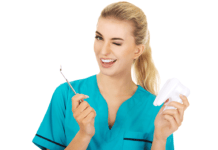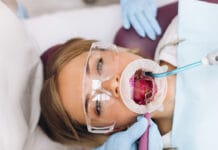With the start of a new year, many of us reflect on how we can improve ourselves. For some, it’s the need to get more sleep, read more, eat healthy, or get in shape. That’s one reason the gyms are full in January, and exercise equipment goes on sale. We all want to be and do better!
All of us are looking for smarter, easier, more efficient ways to accomplish the tasks we face each day. Recently, social media is full of “hacks” for life − cleaning, cooking, moving, or a variety of other things. Webster defines a life hack as “usually simple and clever tip or technique for accomplishing some familiar task more easily and efficiently for life.”
Brilliant, right? I use several of the hack techniques I have learned about when I cook, and they have been a serious help as I love to be in the kitchen. I will take on any little tricks I can to save time, energy, and money.
With that same concept in mind, I applied it to my beloved profession of dental hygiene. Our profession can be one that is filled with many obstacles that can tax even the best and most experienced hygienist. Attached is a list of what I feel are some very useful hacks that I have learned over my years of practice.
In no way is this a complete list of “hygiene hacks,” but hopefully you will find a few that you can incorporate into your daily dental hygiene work routine.
Chart audits – I could not imagine seeing patients without doing these the day prior. It allows the dental hygienist to know if a patient is up to date on needed treatment, financial obligations, any specific request from the patient – no Fl2, or no lip balm, etc. It also identifies if the recall interval is scheduled accurately and if any family members are due so that we can get them scheduled for hygiene also.
Morning huddles – A must to identify specific needs of patients such as new health history, premed, anesthesia, red flags, radiographs, charting, or uncompleted treatment. If it’s a new patient, then you can make sure paperwork and radiographs are onsite as well as a complete insurance benefits breakdown to help speed up that whole process that usually can cause us to run behind.
Operatory set up in advance – If it’s nonsurgical periodontal therapy/SRP, make sure the anesthesia is out and ready for use. If a patient is due for radiographs, have holders/bite tabs easily accessible. If the patient has bridges or implants, make sure the implant scalers, preferred flossers, and home care implements are in the patient’s take-home bag.
Greet your patients with a smile – It can help ease the tension or fear a patient may be feeling. Mix in some of your personal sweetness with all the dental jargon that the patient will be hearing.
Be comfortable in your space – Use a comfortable chair that helps you keep proper ergonomics, ASTM Level 3 masks, proper fitting gloves, loupes if you wear them, and have the most used items in your operatory in easily accessible places (i.e., top drawer) for easy grasp and access. Keeping drawers and cupboards organized and stocked makes for super efficiency throughout the day.
Raise the chair when taking radiographs − If you aren’t bending and stooping, your back will thank you later.
If your patient is a gagger − Have them lift the opposite leg of the side you are taking radiographs on until you’ve exposed the radiograph. It’s just a distraction technique, but nine out of 10 times it works. If not, there is always the salt on the tongue trick.
Gather all info for the exam in the first third of the appointment – Changes in medical history, blood pressure, periodontal charting, radiographs, and any areas of concern should be completed and ready to share with your doctor for co-diagnosis. Letting the doctor know you are ready for an exam after that info is gathered allows the doctor a larger window of time to do his or her hygiene exam. This hopefully eliminates the wait time for the doctor to make it in to do an exam, helping you stay on time.
Use your intraoral camera − A picture is worth a thousand words is so true when talking about dental treatment and concerns with your patient. They can see it right in front of them instead of trying to manipulate mouth and hand mirrors to show them their own teeth. Leave them up on the screen throughout the appointment. Patients love before-and-after pictures of calculus and stain removal.
Polish, ultrasonic, then hand scale – In that order is such a timesaver. Polishing first allows you to remove the soft deposits from teeth so you can easily determine and use the ultrasonic and hand instruments where it’s needed.
Air is your friend – Use it to check for thorough calculus removal. It almost magically highlights those areas we may have missed and allows you to remove those stubborn deposits.
Don’t be afraid to use topical anesthetics – Patients have sensitivity, and anything you can provide to make them less sensitive makes you a rock star in their eyes. Several great products are available for topical anesthesia. Pick your favorite and use it.
Prophy paste holders are such a helpful thing – Different varieties are available, but all of them allow you to easily have the paste on your finger or in your hand to make the process of keeping up with that little cup easier.
Use prophy cups that flare interproximally – This is for nicely polished interproximal spaces.
Heavy stain – Fine flour pumice and hydrogen peroxide is your friend.
Food traps or large embrasure spaces – Tie a knot in your floss and use the knot to clean the area more thoroughly. The size of the space indicates the size of your knot.
Begin oral hygiene instructions with your patient while you are scaling. Areas that the patient needs to work on can be identified as well as areas where the patient is doing well. Complete OHI with any specific suggestions before dismissal.
Don’t give away services – If a patient presents with the need for nonsurgical periodontal therapy/SRP and not a prophy, please have a discussion about their dental health and needs and treat accordingly.
Use saliva ejectors as retractors during hygiene procedures − Those things are so bendy and slim you can almost make them articulate to any area that you may need retraction and suction.
Keep your mouth mirror from fogging up − Either place the face of it on the inside of the patient’s cheek to match the temperature of the patient’s mouth, or you can use a 2×2 dampened with a little mouthwash to swab off the mirror.
Ask patients to move – It’s usually easier for a patient to lift or lower their chin, move their head one way or another than it is for us to try and contort in a position to reach certain places. It’s safer and healthier for both patient and hygienist.
Post nonsurgical periodontal therapy/SRP – Along with using an explorer, check yourself by using unwaxed dental floss to make sure you have thoroughly removed subgingival interproximal calculus.
Be the cheerleader for your patient – Point out all the good things they are doing with their home care or by keeping their recall appointments. A little positive messaging can go a long way.
Recommend specific products – If a patient needs a dry mouth product, caries prevention product, electric toothbrush, specific interdental cleaners, etc., recommend and demonstrate how to use it in the patient’s mouth. If they learn and are able to better care for their teeth, it will save you time and effort on future hygiene visits.
Don’t be afraid to ask − The other hygienist in your office or online groups can provide tips to help you with certain concerns you may have regarding patient care (just be sure to fact check the info you are given against current protocols and research). They both can be a wealth of great ideas.
Happy Hygiene!
Before you leave, check out the Today’s RDH self-study CE courses. All courses are peer-reviewed and non-sponsored to focus solely on high-quality education. Click here now.










